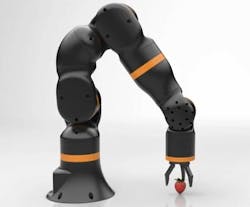When speaking with manufacturers about automation trends, they’ll often focus on those specific to their operations and recent or planned projects. Similarly, with technology suppliers, they’ll tend to focus on the trends around the products they happen to offer or are promoting at a particular time.
Speaking with technology distributors, however, can offer a different level of insight. The reason being that distributors sell nearly every type of automation technology or component a manufacturer may need. With a goal of maintaining an inventory of so many types of technologies, distributors have unique insights into what’s happening in manufacturing at any given time.
DigiKey is a distributor of electronic components and automation products that offers more than 15.3 million products from nearly 3,000 original equipment manufacturers. The company ships, on average, 25,000 products around the world each day.
At Automate 2024, Automation World spoke with Eric Halvorson, automation and control marketing technology manager at DigiKey, to get a sense of where things are going with the manufacturing industry’s adoption of automation technologies now that issues with the electronics supply chain have largely corrected post-COVID.
Robotics and economics
“We're seeing a definite pickup in robotics as well as in motion technologies, whether it's drives or motors,” said Halvorson. “Mobile robots, in particular, are a big thing. With the difficulties in getting electronic components now behind us, we're seeing our lead times coming back to normal. And, with that, I think a lot of customers are in a kind of design phase—building their new product and process prototypes. Today, customers are focused on getting these new automation products to get their design research done.”
Halvorson added that DigiKey is seeing this across the board—from food and beverage to the oil and gas industry.
As for his insights into the potential for a hard or soft economic landing this year, Halvorson noted that the electronic components side of the business is a little slow due to inventories having been kept on the high side for a long time. But DigiKey’s business for automation products, though it did slow down a bit, never really dropped off.
“We have a higher customer count now than we've ever had before,” he said, “and automation is now 10% of our business. We expect it to grow much, much higher. With all the labor issues industry continues to face, coupled with competition from lower-cost labor markets, automation is really what's going to bring everything back to the U.S., especially with the onset of collaborative robots and the rise in use of augmented reality for training.”
AI, digital twins and the growing influence of IT
In terms of manufacturing’s interest in artificial intelligence (AI) technologies, Halvorson said it’s still on the horizon for DigiKey. There's definitely a customer interest in it, he said, but the larger areas of customer interest are still on edge computing and digital twin applications.
Interest in digital twin technologies at companies of all sizes is increasing, Halvorson said, because it can be used even for very small applications to ensure you have, for example, the right workforce on shift at the right time or if you need to update your controller programming. “With a digital twin, you don’t implement anything on the shop floor until you know it's going to run as expected,” he said. “You can know what your peak hours are for production, what your downtime is and what you need to do to make sure your scheduling is up to speed. It’s all about making sure all your efficiencies are in place so that you’re not creating more waste.”
Halvorson noted that “what we're mostly seeing now is a lot of customers that are new to automation. And many of these customers aren't from traditional automation fields. They don't program in Ladder Logic, they’re programming in Python or C++. We're also seeing interest around Codesys because it allows IT or OT (operations technology) customers to program in the languages that they're used to using.”
Driving this is the increasing influence of IT on OT. “The IT guy, he's not just putting in servers now,” said Halvorson. “He's also figuring out how to put a robot in to work on depalletizing or palletizing.
This combination of new customers unfamiliar with advanced automation and driven by IT is boosting DigiKey’s business around low-cost collaborative robots. For example, DigiKey recently started working with Igus around its new Rebel lightweight cobots, which is “a low-cost entry-level robot platform that has about 80% to 90% of all the functionality of a regular cobot,” said Halvorson. “There's also the Schneider Electric Lexium cobots that are a fraction of the cost of many cobots. These kinds of robots are flying off the shelf. It’s about customers being able to get these low-cost robots and learn how to use them to prototype work cells before spending the $50,000 or $100,000.”
Summing up DigiKey’s role in industry, Halvorson said the idea is that “no one manufacturer can create or build it all. That's where DigiKey comes in. Our goal is to make sure that the customer can find everything they're looking for—whether it's specific products or the content around it they may need, like data sheets or 3D CAD models.”
The video below highlights several of the automation technologies on display at DigiKey’s exhibit at Automate 2024.
Leaders relevant to this article:




